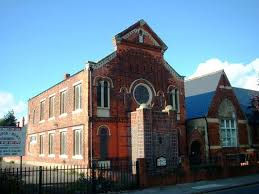Op Ed in Jewish Chronicle
- Nov 4, 2019
- 3 min read
Updated: Oct 24, 2020
The Jewish Chronicle invited the Foundation to write an opinion piece presenting its work.
How we are preserving the synagogues and stories that once made up Europe’s Jewish communities
Michael Mail from the Foundation for Jewish Heritage explains his organisation's work documenting and preserving synagogues across the continent
Standing on the bimah of the Great Synagogue of Slonim in what is now Belarus was a profound and moving experience. The ghosts swirled; someone in our group cried.
The Nazis set out not just to annihilate Jewish people but also to destroy their culture, consigning their very existence to oblivion.
In places like Slonim, you feel that they succeeded. Nothing is taught today in the local schools about the Jewish history of the town. The local museum does not mention the Holocaust.
Yet Slonim in 1939 had 17,000 Jews — in a town of 25,000. It was a thriving Jewish centre that included a famous Chassidic dynasty. Very few survived the mass executions that took place during the Second World War, and a community going back centuries was brutally extinguished.
The only witness that remained was the Great Synagogue itself, built in the 1640s, a hulking, brooding presence in the centre of the city — shattered, yet majestic. It was used to store furniture after the war and, for the last 20 years, has lain abandoned.
So what do we do with this building, indeed with all these historic, often beautiful synagogues across the landscape of Europe that so tragically lost their communities?
Many are the last testament to the Jewish life that was and, if they disappear, there will be no physical evidence that these communities ever existed.
There are many who will say “who cares?” Yet these buildings represent the patrimony of the Jewish people — they tell our story, where we came from, who we are, and where we are going. Winston Churchill once wrote that “if we don’t know our past, we don’t have a future.”
By saving these buildings, we honour the communities that these buildings once served.
They can become powerful sites of education on Jewish life, educating Jewish people and wider society, combating ignorance and prejudice, and serving as embassies of the Jewish people.
This is the view that drives the work of the London-based Foundation for Jewish Heritage.
The Foundation commissioned unprecedented research to map all the 3,347 historic synagogues of Europe in order to identify the most important sites most in danger.
The Great Synagogue of Slonim was one such building highlighted through this research. A former synagogue in Wales is another.
Merthyr Tydfil was the industrial powerhouse of Wales in the 19th century and its largest town.
There was a Jewish presence in Merthyr since the 1830s and the construction of the synagogue in 1872 reflected a community that was growing and prospering.
Today, Merthyr synagogue is grade 2 listed, the oldest purpose-built synagogue in Wales and considered architecturally one of the UK’s most important synagogues.
With the demise of the Merthyr Jewish community in 1983, the synagogue was sold and, for the last 13 years, the building has been lying empty, its condition deteriorating.
The Foundation recently bought the building with the widely-supported idea to create a Welsh Jewish Heritage Centre that will present the history of Welsh Jews spanning over two centuries.
Another priority project for the Foundation is supporting efforts led by the Israeli-based Kiriaty Foundation to save the Etz Hayim synagogue in Izmir, Turkey.
This is the most ancient of a cluster of nine remarkable Sephardi synagogues in the old quarter of a city of almost 4.5 million, and there is a broader vision to restore them all and create a “Jewish Cultural Quarter” as a visitor destination with a museum at its heart.
The Foundation for Jewish Heritage exists to play its role in saving Jewish history — to fight oblivion.
We want to find solutions for these historic buildings that can bring them back into use, and in a way that serves educational purposes for the benefit of the Jewish people and wider society.
We are dealing with the past, but are future-focused, taking buildings that had become meaningless and making them meaningful once more.
Buildings are stories, and these stories — dramatic, profound and glorious — are vital for our world of today.





Comments